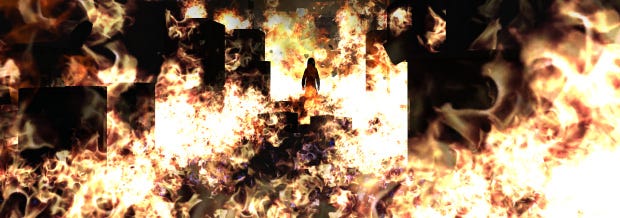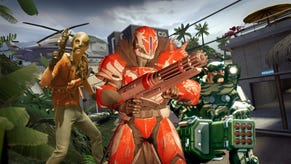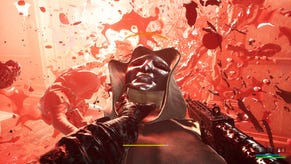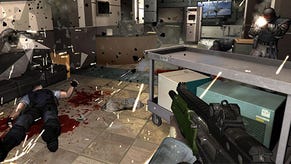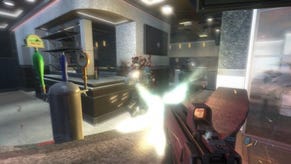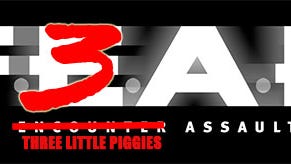Dark Signal: The Origins Of FEAR
The Art Technology of FEAR
Update: A second conversation with Craig Hubbard revealed a few more details, so I've added them where appropriate. The section 'Mergers And Executions' now talks more about cut villain Conrad Krige and the game's improbable original opening (a car chase), while a new section on its famous radio chatter has been added to the end.
In this second of three conversations with the Monolith veterans at Blackpowder Games, whose debut Betrayer is kind of available now, it's time to look at FEAR: First Encounter Assault Recon. Well, it is if you do things backwards.
Here is a game I still believe has the best AI combat of any firstperson shooter. Nuts, you say, but then you might also think I'm talking solely about combat AI, whereas an arguably greater part of selling gunfights against robots is artistic. FEAR's ragdoll weighting, for example, by animator Andrew Grant, is second to none: you drop a guy in this game and they go down like a sack of steel-plated guts. Fire a high velocity metal stake through their head and you nail them to the goddamn wall.
In a system that's only as good as its least effective part, audio doesn't slouch. Chop at the armour of a Replica Heavy and you'll see and hear sizzling chunks of metal burrow into kevlar, making the brute do his 'so that's what my kidneys feel like' dance. That reciprocates to the weapons, of course, setting apart the Type-7 sniper beam as it atomises flesh and chucks smoking bones at your enemies. Close enough with the combat shotgun and you can pretty much breathe your victim in. There is no pea shooter.
As a proportion of actual game time, in fact, the most fear in FEAR is that of enemy soldiers yelling 'SSHHIITT' before diving through windows for their lives. What else would a supposedly smart person do? The game's next trick, one of its creators' favourites, is to turn this empowerment against you whenever you forget to be scared, as you really should be when a girl like Alma Wade has your number.
Capital Jitters
I've always quite liked the name FEAR: First Encounter Assault Recon. You might quite like it, too, though maybe less so after reading the next few paragraphs. I like the typography, the way it works in any format at any size. I like how it makes idiots like me have to write it in giant capital letters, suggesting that only it, STALKER and VIP starring Pamela Anderson should be shouted from the rooftops. And I like the acronym, believe it or not, that military twist. It says to me 'Ghostbusters with assault rifles', which is mental.
Know what I like more? This:
Craig Hubbard: We didn't actually come up with the name. We didn't want an obviously horror name. We wanted something a little more mysterious, so that when you played it it felt like an action game with a horror twist to it, as opposed to a game where you're going in expecting to be scared.
We had one name we wanted to use but it didn't fly: Signal. It tied into the fact that as you're exploring there's this strange-- things keep cutting into your radio transmission, so it's that notion of being communicated with. The other part of it is that we'd spent four years making fun of acronyms, so to suddenly have an acronym wasn't... it wasn't our favourite. I think in retrospect I'm fine with it, it's just that at the time we were really set on a different approach.
The typography was David. If you look at the logo David designed you can see how he tried to de-emphasise the acronym aspect of it, which I think looks really cool and actually does add some of that futuristic military thing you're talking about.
David Longo: The type is actually reworked from a Neville Brody font that I really liked that had just this strong weight to it.
Bumps In The Night
FEAR was just a difficult game in general. Players really had to learn its options to achieve framerates fit for a mouse-look FPS - the game was terrifically top-end for the year after Half-Life 2 - while its developers faced down their own next-gen demons.
Hubbard: In the past we'd been able to go on polygon count and things like that to get an intuitive sense of where the performance was going to be. On FEAR there were so many variables that you really had to come to understand the technology to even begin to predict what was going to work. We knew from the outset that we weren't going to be able to do a lot of lights and so on, but still there were so many parameters that you had to get a sense of how they all worked before you could really build environments that were going to be viable, and that was really gruelling.
I don't think it's a matter of horror games generally being expensive because there are a fair number of relatively low budget horror games, and even some recently, like the Penumbra series. The challenge with horror is that it takes a lot of iteration to get it right - because you have to react to how people are playing because it's dynamic, and you don't know where people are going to be looking. So you have to kind of set something up you think is going to be cool, then watch people play and see if it's working, and if it's not then you have to keep tweaking it until it's effective.
For Everything A Reason
If the rhythm of horror evokes musical composition, FEAR is a virtuoso not just in the performance. Timing the scares in such a way as to keep people playing, shredding and healing nerves and tempo, is a torturous process in itself. Some of the time, at least.
Hubbard: We had some ideas we thought would be cool upfront that we specifically built as horror showcases, but then there were other places where it felt like an opportunity. It always works best when you're not expecting it, where as a player you're intuitively thinking, 'Okay, at this point I'm a little off-guard, in a mindset of just going from point A to point B,' so this is a perfect time to interrupt that with something chilling.
It happens a lot where we have an intuition about something and then, as we play test, it starts to feel good and we go with it. I don't think we're quite smart enough to foresee how it's all going to work out.
Longo: There were a lot of unexpected moments that people were introducing late in the game. Our producer, Chris Hewett, he came up with some ideas to just add extra scares in places where he thought it would feel good. I know Jared [Gerritzen, level designer and now creative director of Blacklight creator Zombie] also did one of the sequences with the tiles coming off the walls. So there was a lot of collaboration, and people seeing opportunities to include something they thought would add something more to the experience in a particular area.
The most fun memories I have from development was Craig would occasionally grab people from the team and say, 'Come into my office, I want you to play something.' There's one when Alma's doing her crazy crawl across the floor, and everybody who played it jumped. And he kept pulling in more people, and people would just stick around to watch the scare for the next person.
Girl Power
Late to the J-horror party - Hideo Nakata's Ringu and Takashi Shimizu's Ju-on: The Grudge had come, gone, and been remade by 2005 - creepy haircut girl Alma Wade is still a force to be reckoned with in FEAR. A heady dose of Akira helps, Alma channeling the apocalyptic Tetsuo as she decorates rooms with her victims, threatening to break quarantine whenever she gets round to it. Post-Fukushima, her interest in a city's water treatment plant has a heightened chill.
Hubbard: The thing about FEAR is that we actually started on the project before The Ring came out in the US. We thought we were being really novel and doing something that would come out of left field, but by the time we released, because games take so long, that had already crested.
In any case, I don't want to give too much credit to us for the concept because I was pretty heavily inspired by the novel The Ring, in which Sadako is kind of a viral ghost. She's basically raped by someone who has smallpox, one of the last people, so I was really intrigued by that notion of a viral ghost who's changed into a different kind of virus that spreads somehow through this tape.
When I was a kid, where I was growing up there was a project in Southern New Mexico to dig a deep hole and put a bunch of toxic nuclear waste in it. People understandably were very concerned about it because science suggested it was a ticking timebomb where the salt would fill in the cave and crush the containers, and it would all leak out into the water table. So that was kind of something I'd internalised, and the thought of then turning her into a very literal toxic waste thing, with a nuclear overtone, was a cool spin on it, and would be much more apocalyptic, and more visceral. Akira was a huge influence.
Reality Bites
Japanese influences aside, the common thread throughout FEAR is physics simulation. It's hard to overstate the benefit of knowing that the same realistic system behind the spiralling props and body parts of its combat gives Alma her powers, from blowing entire rooms apart to subtler poltergeist phenomena. Perhaps it's only natural that one of the first heavily 'physicalised' games is also one of the best, even if that caused a whole heap of problems.
Hubbard: It's a very direct reaction to something that you've done, and you can feel your impact on the world even if the physics are very cartoony and not realistic. That's a lot more satisfying than a canned response, but even a canned response can be fun if it looks and sounds good. But that was something that, early on, we didn't have that we were desperate to have because the movie references that we looked at, like Hard Boiled, a lot of it comes down to: a gun gets fired and stuff flies.
Early on we mocked it up to kind of show what we wanted with the animation. Chris Hewett, our producer, had set it up so you'd shoot a guy and he'd fly back over a desk and stuff would fly off. It was all canned but it was really satisfying, so we instantly knew that was exactly what it had to be. It was also why our initial focus was on nailing the combat.
The opening tea room sequence of Hard Boiled is everything you need in a game, it's so explosive and incredible. So we spent a lot of time trying to get that to work in a box, and once we had that we knew what we could get away with. But there were still a lot of things we thought we could do that we ended up not being able to.
We were using shadow volumes and not shadow maps, which is what everyone's using now, and when a shadow volume is going horizontally across the screen it eats up a lot more performance than when it's top-down. (I'm not a rendering guy but this is my understanding of it.) There'd constantly be these cases where a room looked really simple, like it was going to work, but then you'd put a light in it so you could see and suddenly it just dies and you can't have combat in there. There was a lot of that sort of thing.
Also, because we were dealing with normal maps for the first time and just getting a handle on that, there was a lot of expectation of what we could do based on No One Lives Forever 2, where we really had our system down. And it wasn't a good gauge to go by, so we had to pull a lot of stuff out of the game.
Midnight City
Two things that often go together in games are strong senses of place and time. Like Rocksteady's Arkham games, FEAR takes place across a particularly bad night in a place of obvious significance - and interest - to the outside world. Though confined to the cubicles of a years-old FPS, you're seldom out of sight or earshot of the game's anonymous American city. Turn on a radio and its airwaves, always several steps behind, paint fuzzy pictures of a catastrophe in progress.
Longo: You're trying to just flesh out an area, keeping in mind where this is supposed to be and giving that impression that it doesn't just end with the space that you're in, but continues. It was really tricky with FEAR to get some of that to work, but we did the best we could.
A lot of it was technology; we had a pretty tough set of tools to work with. We were trying to keep the areas small. Even close quarters combat was sort of a by-product of some of the limitations of what we could do with the technology. On the art side it was challenging.
Two things I wish we could have done better. More memorable landmarks: there's a lot of claustrophobic maze-like areas where we had to break up offices and industrial areas, and even the underground facility, where it became a little bit repetitious. It would have been nice to have a couple more standout centrepiece experiences where you get a little bit of a breather, and feel like you've progressed and been rewarded visually with something new. We didn't have as much of that as I wish we could have done, but then I think we also had five environment artists on the team at the time.
The second thing would be just adding a bit more storytelling to the environments. We had so much real estate to complete the game. Compare FEAR to Condemned 1 which was being done at the same time; they probably had a similar-sized art team to us, but the game is much smaller, so being able to go back and break up some of the big shapes in the work with more distress, stain decals coming down walls, things that just give it more of a richness... That's something we just couldn't afford to do because we had so much to work on. It's easily four times bigger [than Condemned] in just square footage.
Man Of The People
David Longo's Flickr feed offers a teasing glimpse of his work on Monolith's best games, one caption revealing that FEAR, along with all its other compromises, had no concept art team. Were there advantages and disadvantages?
Longo: Umm, there were disadvantages. For FEAR I was the art director but also the-- I can't remember what the title was in the end, some kind of 3D whatever [Coordinator]. I was putting together the schedules for all the 3D guys, and then later on Wes, our technical art director, had his first child so I'd do the schedules for all the environment artists as well. All these things just spread what you can do a little thin.
I had to do the concepting for characters, and also some of the environment work and propagation work and whatever, so I just see disadvantages. I'd have loved to have had a fulltime concept person, it definitely frees up people like me to focus more on just trying to really polish the experience and give everybody as much attention and feedback as I can. But it's fun to do at the same time. I really enjoyed being able to contribute in that manner, but yeah, I think we could have used a concept artist.
Mergers And Executions
In the sense that characters are few and far between, each encounter a little light in the darkness, FEAR seems perfectly cast. Paxton Fettel, the psychic cannibal antagonist, is a big enough presence to allow Alma and her arsenal of POV-hijacks and poltergeist tricks to take on an omniscient, environmental role. Geek fatbody Norton Mapes provides vital comic relief, while Armacham president Genevieve Aristide and amoral scientist Harlan Wade are the parents (only one of them literally) of the game's battling enfants terribles. It wasn't such a tight fit originally, though.
Hubbard: One of the things that happened on the project was that, early on, I made the mistake of over-drafting the story. FEAR was really the project that taught me not to do that, made it crystal clear. And it was because I'd drawn up all the stuff for all the characters, and that required twice the game than we actually made. So we ended up cutting half the game, and things like the personality of the other characters fell away. But Norton Mapes was so tightly integrated into the levels he was in that he sort of survived it.
This was also one of the liabilities of being stuck with the name FEAR: it forced us to keep this notion of this FEAR team, this made-up thing that had an expository overhead. Later in the project I came up with the perfect solution, which was to make the main character a military guy that gets called in, like a SWAT guy. Because that doesn't require any exposition, you just know how it works. So then it could have been much more constant. Right at the beginning of the game, where you're locked in place and being talked to about the situation, is a total band-aid solution to the exposition thing: let's just get it out of the way.
The role Paxton Fettel ended up in is very much meant to provide misdirection, to make you think that he's the villain going after the innocent victim. He again, like everything in the game, sort of evolved from a different role. He wasn't the main villain, originally, but we ended up consolidating just because there wasn't enough storytelling real estate. When we cut stuff we basically kept all the action scenes, so there wasn't a lot between them to get the story across.
The other original villain was Conrad Krige - in tribute to Alice, who played Alma Mobley in Ghost Story, which as you can probably guess is where I got the name Alma. Well, it was really from the book, which is one of my favourite horror novels. Anyhow, the idea was that the player, Krige, and Fettel were all prototypes. Fettel was kind of a failed experiment who served as interrogator (by eating the flesh of his victims to steal their thoughts), whereas Krige was the perfect soldier. The problem was that there wasn't enough room in the game to have Krige do anything that would really dimensionalise him as a character.
One action scene that notably didn't make it was the car chase. The idea was to start in media res during a high speed car chase with someone else driving and you fighting enemies on motorcycles and evading a gunship. The thing was that in my opinion it needed to be simple and visceral, but the prototypes kept turning out overly complicated and hard to play, with lots of twists and turns and jumps that looked cool from outside the car but were nauseating from the passenger seat. In the end, way too much effort went into it because people liked the concept, but we finally killed it.
Chasing Ghosts
The less-is-more approach of a Jaws or Alien seems anathema to games that are several times longer than a movie, flooded with ambient light, and home to ultimate badasses. FEAR's combat is its solution, each gunfight like a raucous rendition of Show Me The Way To Go Home. And when Alma or some other nightmare does appear, it's always through a fug of psychic turbulence, blood-smeared frosted glass, or some other tech-driven disguise.
Hubbard: You want to see something just enough that you can evoke it in your mind and kind of picture it a little bit, but not enough that you can really understand it. It's like a song: once your mind fully understands it, it's no longer interesting to listen to. But that point where you're trying to make sense of it all, trying to pick up on all the subtleties of the arrangement, it stays fascinating. Horror works in much the same way.
One of the reasons for the glass was that when you did transparent glass you couldn't see it, because at the time it wouldn't pick up any specular lighting, so we couldn't make it visible. But we certainly tried to take full advantage of the frosted glass. In the Kiyoshi Kurosawa film Seance, based on Seance On A Rainy Afternoon, there's actually a scene like that where you see something through frosted glass and it's just super creepy - and you know that if you could see through the glass it would lose all its impact.
Because of the way we work, you get a scene in there and if it feels like you're seeing too much and it's not quite effective, you just keep tweaking the timing until it's just enough to get an impression. Alien was an indelible experience for me. My friend's mom had the novelisation and she read it, then my friend read it, and then he gave it to me. We were out fishing on the day the film came out, and all three of us were like, 'We gotta go see this.' So we got in the car and headed back to town and were just completely blown away by it. But a lot of that is because you never get a full understanding of the creature. But at the same time, as a horror fan, I love to then get the behind-the-scenes book that shows the actual models, and then to understand it. Because it's sort of disassociated with the film, I can still see the film and be completely scared by it.
Longo: I think that when we - the artists and the art team - set out to make an asset, we're trying to anticipate any possible use of it, even a quick scare, something you'll see for only a fraction of a second. If it doesn't have the love and attention the artists like to put into something, you'll notice it, or at least the artist who made it will notice. So I think everybody did try and do the best that they could to make sure things looked the best under any circumstances.
Shockwaves
Hubbard's love of Alien may not have instructed FEAR composer Nathan Grigg, but elements of Jerry Goldsmith's incredible score, alternating as it does between melancholy, wonder and monstrous Giger-esque soundscapes, must have. Sometimes little more than a heartbeat, it feels remiss to mention the game's soundtrack last.
Hubbard: Audio is a huge part, and it goes back to what we were saying about the expense of horror. If you've got good audio design then, in my opinion, you've done 90 per cent of the horror, especially when it plays with your expectations. The sound from The Grudge, for example, is that whole film. The score of Alien was just so jarring and unnerving: there's a melancholy vibe to it that turns into almost a scream. I just love it.
We had a great composer who really got what we were trying to do and developed it. I still think that music he chose for the opening cutscene was just so perfect, really unsettling and off-putting but at the same time really beautiful. And there's some playful stuff in there. It really helps with pacing when you're not monotonous with your music and can come out of left field with it, let off the pressure a bit.
Anything can come back to music as example, and if things become too patterned or too regular, it goes back to that notion that your mind can understand them quickly and dismiss them. Kurosawa - I saw an interview with him where he talked about how he deliberately leaves some awkward edits in his films that would be easy to fix, but he does it because his feeling is that if the film's too smooth, you're just done with it. Whereas if it jars a bit, it sticks with you a lot longer. So that was something I read early on that had a big influence.
Chatterbox
A quite separate and no less important part of the soundtrack is the game's famous radio chatter. Nothing tells you the enemy is losing its shit quite like an argument over which tragic Replica soldier has to go over the top to face that lunatic (you) who can almost outrun his own bullets. At the risk of spoiling the magic, this three-part series of YouTube clips reveals the extraordinary amount of VO it required.
Hubbard: For the enemies, what happened there was that we realised players weren't picking up on all the cool things the AIs were doing and reacting to, so we made them call out their behaviours. Someone also came up with the idea of having them reference the player's location, which I loved conceptually but was terrified of technically. But it worked out okay.
Getting the VO right was actually a pretty gruelling process. Actors generally don't like to shout because it blows out their voices, so it took a lot of experimentation and failed attempts to get the right level of intensity without ruining any voiceover careers.
As for story dialogue, there was a lot more of it originally, but as I was implementing it, I realised the game was feeling much too cluttered, so kept distilling it down to be as concise as possible. I think I threw away about twice as much dialogue on FEAR as I wrote on NOLF 2. But the less there was of it, the more effective it felt.
The other issue was that we discovered that when players are in the mindset of playing the game and worrying what's around the next corner, they don't really pick up on voiceovers that don't bear directly on the action, so you have to find moments where the audience is going to be receptive. Again, it was mainly an issue because of the expository overhead I mentioned earlier. Had we been able to scrap the notion of the FEAR team, we could have kept the storytelling more visual and experimental.
